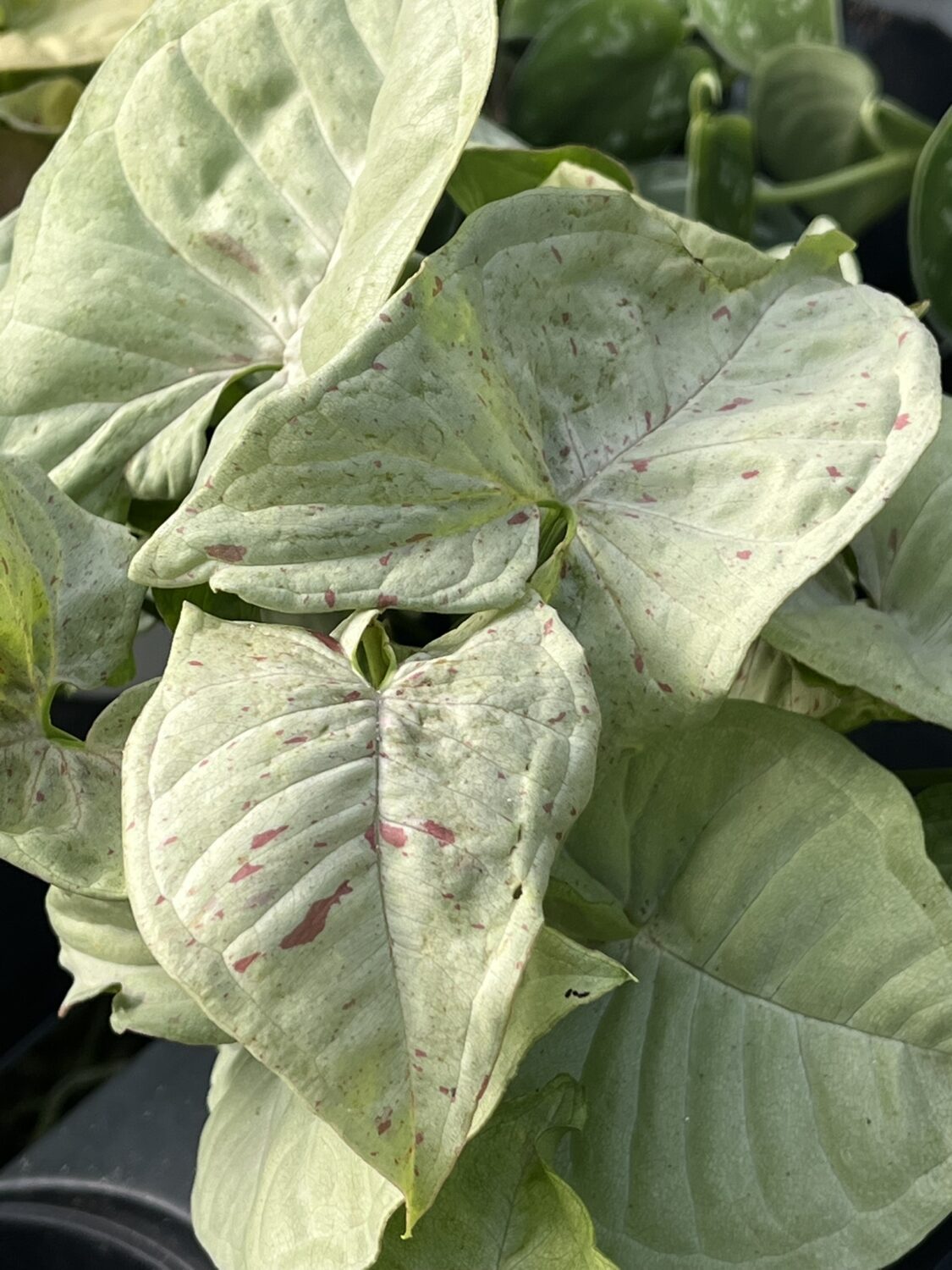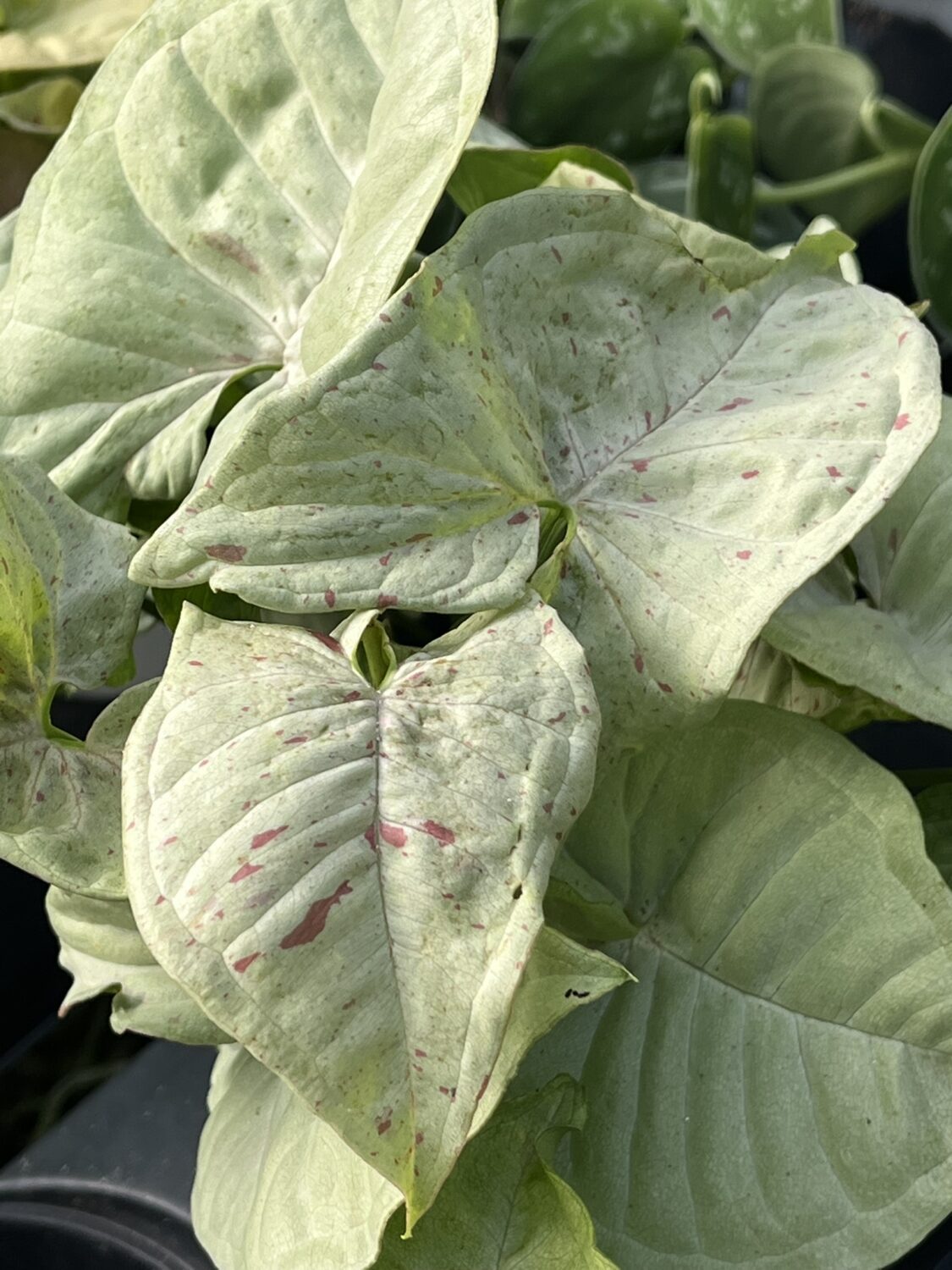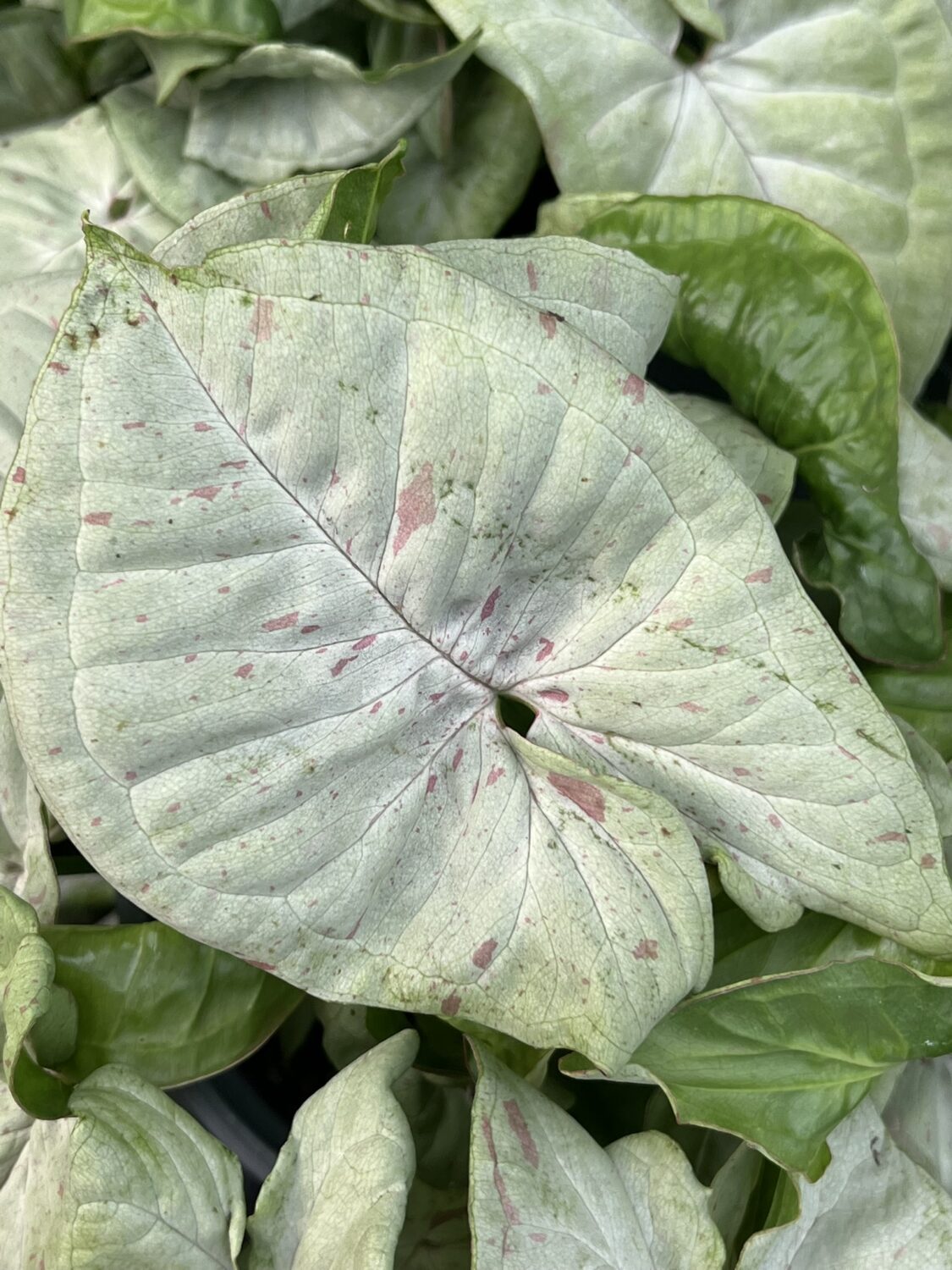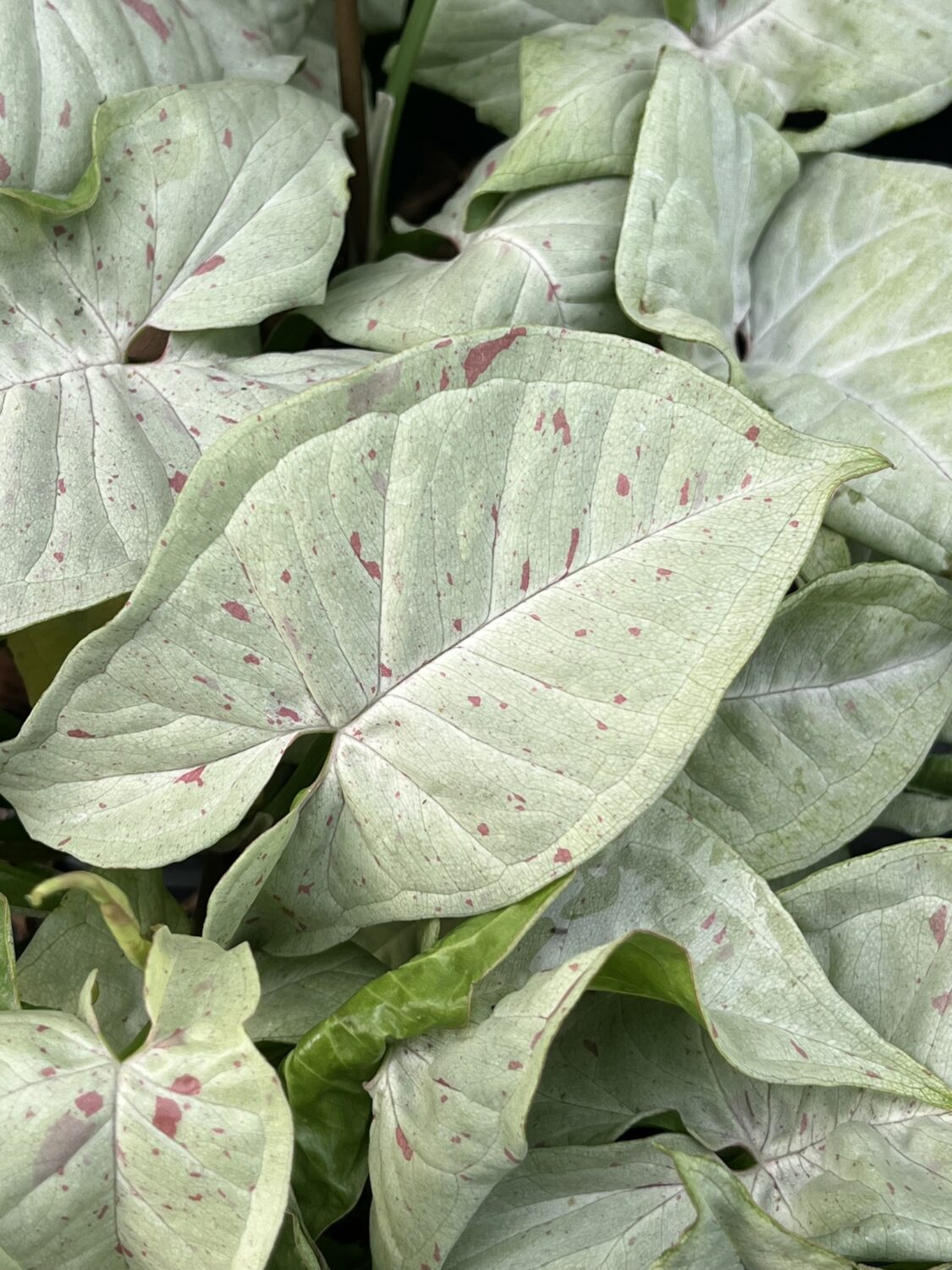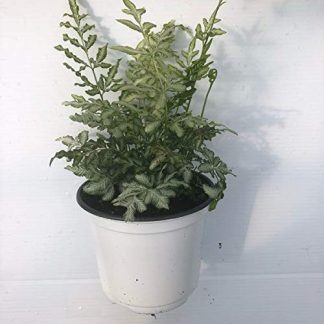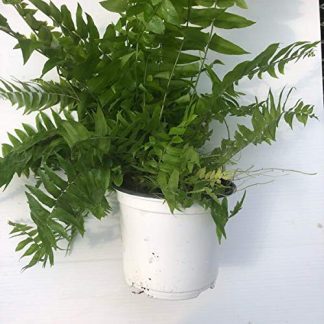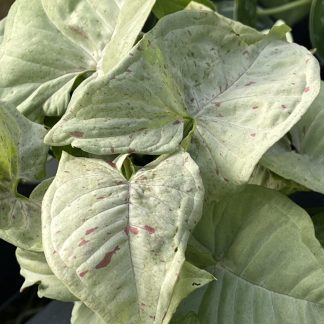Description
Syngonium podophyllum ‘Milk Confetti’: A Playful Arrowhead Vine with Pastel Charm
Some houseplants quietly blend into a room. Others demand attention the moment you see them. Syngonium podophyllum ‘Milk Confetti’ belongs to the second group. Its soft cream leaves, brushed with splashes of pink and red, look like tiny pieces of confetti scattered across a canvas. Subtle yet bold. Playful yet elegant. This balance makes it a favorite for plant lovers everywhere.
In this guide, we’ll explore what makes this Syngonium so special and how to help it thrive in your home. Whether you’re a beginner or a seasoned collector, you’ll find that this plant rewards even modest care with vibrant, fast-growing foliage.
Why ‘Milk Confetti’ Captures Hearts
Native to the lush rainforests of Central and South America, Syngoniums have been treasured for decades for their arrow-shaped leaves and easy nature. The ‘Milk Confetti’ cultivar takes this appeal to a new level with its unique variegation. Each leaf feels like a piece of art. No two are alike.
This plant is also highly adaptable. It can trail gracefully from a shelf, climb a moss pole, or sit compactly on a tabletop. It thrives in hanging baskets, small decorative pots, or larger statement containers. On top of its looks, it’s also known to help purify indoor air, adding function to its form.
Getting Started: Propagation and Planting
One of the joys of growing Syngoniums is how easy they are to multiply. Stem cuttings are the most common method for propagating ‘Milk Confetti.’
How to Propagate Step-by-Step
-
Take a cutting just below a node using clean scissors or pruning shears. Make sure your cutting includes one or two leaves.
-
Prepare the cutting by removing the lower leaves to expose the node.
-
Choose water or soil:
-
In water: Place the cutting in a clear jar, ensuring the node is submerged.
-
In soil: Plant directly into moist, well-draining potting mix.
-
-
Provide bright, indirect light and wait for roots to form. This usually takes 1–2 weeks.
-
Transplant rooted cuttings into soil once roots are about 1–2 inches long.
Tip: Propagation is easiest during spring and summer, when the plant is actively growing.
Light: Bright but Gentle
‘Milk Confetti’ shows its best colors in bright, indirect light. Too little light, and the pink splashes fade. Too much direct sun, and the creamy leaves may scorch.
-
Indoors: An east- or north-facing window works well. A sheer curtain can soften strong south or west light.
-
Outdoors: If you move the plant outside for summer, keep it in dappled shade. Avoid harsh midday sun.
While this plant tolerates lower light, vibrant variegation is your reward for keeping it well lit.
Soil: Light and Airy
Like most aroids, Syngonium ‘Milk Confetti’ thrives in a mix that drains well yet holds some moisture. Compact, soggy soil is its biggest enemy.
Ideal Mix Recipe
-
2 parts potting soil
-
1 part perlite or coarse sand
-
1 part coconut coir or peat moss
This combination ensures roots get both moisture and air — key to preventing rot.
Water: Keep It Consistent
This plant likes evenly moist soil but doesn’t want “wet feet.” Overwatering can lead to yellow leaves and root rot, while underwatering causes drooping foliage.
Best practice:
-
Water when the top inch of soil feels dry.
-
Reduce frequency in fall and winter as growth slows.
-
Always empty excess water from saucers to prevent standing water.
Watch the leaves. Drooping often signals thirst; yellowing usually means too much water.
Temperature and Humidity: Think Tropical
‘Milk Confetti’ comes from humid rainforests, so it thrives in warm, moist conditions.
-
Temperature: Keep it between 60–85°F (15–29°C). Avoid drafts and sudden temperature swings.
-
Humidity: Aim for 50% or higher. Misting, pebble trays, or a humidifier can help in dry indoor climates.
If leaf edges brown, it’s often due to low humidity rather than underwatering.
Feeding: A Boost for Vibrant Growth
During the active growing months of spring and summer, your plant will appreciate a little extra nutrition.
-
Use a balanced, water-soluble fertilizer diluted to half strength.
-
Feed every 4–6 weeks.
-
Pause feeding in fall and winter when growth slows.
Flush the soil occasionally with plain water to avoid salt buildup from fertilizer.
Pruning: Shape and Multiply
Pruning keeps your Syngonium compact and encourages fuller growth. It also gives you cuttings for propagation.
-
Trim back leggy vines using clean scissors.
-
Remove any yellow or damaged leaves to keep the plant tidy.
-
Pinch back new growth tips to promote branching.
Pruned stems root easily, so nothing goes to waste.
Common Pests and Problems
‘Milk Confetti’ is generally hardy but can attract common houseplant pests:
-
Spider mites leave fine webbing on undersides of leaves.
-
Mealybugs look like white cotton clusters on stems.
-
Aphids may cluster on new growth.
Simple Pest Solutions
-
Wipe leaves with a damp cloth or mild soapy water.
-
Spray neem oil or insecticidal soap for stubborn infestations.
-
Improve air circulation and inspect regularly to catch issues early.
Root rot is the most common disease problem, usually caused by overwatering or poor drainage. Always check soil moisture before watering.
Repotting: Give It Room to Grow
As a fast grower, this plant may outgrow its pot every 1–2 years. Repot when roots circle the pot or push through drainage holes.
-
Choose a pot 1–2 inches larger than the current one.
-
Refresh with fresh, well-draining soil.
-
Handle roots gently and avoid planting too deep.
Repotting is best done in spring, giving the plant an entire season to settle in.
Styling Tips: Show Off the Pastels
The delicate pink splashes of ‘Milk Confetti’ shine brightest against neutral backgrounds. White pots, wooden shelves, or hanging baskets all make great choices. Pairing it with darker green plants creates contrast and makes the variegation pop.
If you want a climbing look, train it on a moss pole or trellis. For a softer, cascading effect, let it trail naturally from a shelf or basket. Either way, rotate the pot every few weeks to encourage even growth.
Seasonal Care Reminders
-
Spring/Summer: Active growth — propagate, fertilize, prune, and water regularly.
-
Fall/Winter: Slower growth — reduce watering and pause fertilizer. Bring indoors if temps drop below 50°F.
-
Year-Round: Wipe leaves to remove dust and keep them photosynthesizing efficiently.
Why It’s Worth Growing
Syngonium podophyllum ‘Milk Confetti’ combines whimsy and ease. Its soft, pastel palette works in modern and boho homes alike. It’s forgiving for beginners but rewarding for collectors who crave rare variegation. With just a little attention — light, moisture, and occasional pruning — it becomes a living piece of art.
A Final Sprinkle of Joy
Bringing ‘Milk Confetti’ into your home is like adding a quiet celebration to your space. Its leaves tell a playful story with every splash of pink and cream. Easy to grow, endlessly adaptable, and striking in any setting, this plant is proof that small details can transform a room. Care for it well, and you’ll enjoy its pastel confetti for years to come.

